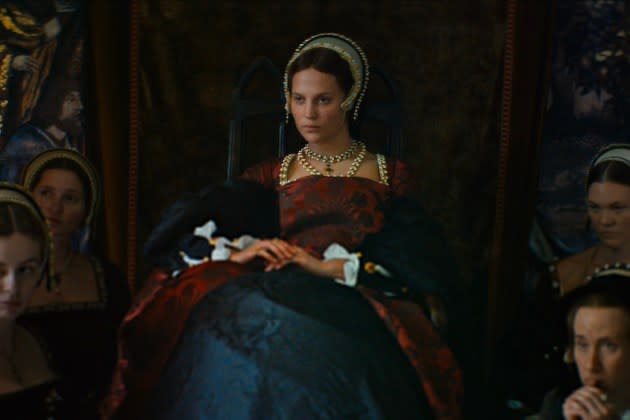‘Firebrand’ Review: Alicia Vikander Brings Subversive Edge to Ahistorical Portrait of Henry VIII’s Last Wife
- Oops!Something went wrong.Please try again later.
- Oops!Something went wrong.Please try again later.

Tudor, or not Tudor. That is the question in “Firebrand,” a revisionist royal portrait of Henry VIII’s last wife, Katherine Parr (played here by Alicia Vikander), that features all the pageantry you’d expect from a lavish costume drama, while showing the ahistorical audacity to call “Time’s Up” on the gluttonous king (Jude Law). Never mind that Henry VIII died — of very different causes than the movie depicts — all of 476 years ago. When it comes to art, there’s no statute of limitations on taking toxic masculinity to task, which can be both encouraging (since history has excused no shortage of monsters) and frustrating.
There’s a big difference between exposing the truth and rewriting what came before to suit a contemporary political agenda, the way “Firebrand” does. Liberally adapted from Elizabeth Fremantle’s fast-and-loose historical fiction “The Queen’s Gambit,” director Karim Aïnouz’s tony yet dull British production needn’t try hard to demonstrate that Henry was a notoriously bad husband. He had two of his wives beheaded, and kept his sixth — as well as most of the court — on their best behavior by allowing them to believe that they could be next to have their necks and/or lives shortened.
More from Variety
Far from any fairy tale, Aïnouz’s film begins not “once upon a time” but “in a blood-soaked and rotten kingdom” where “history tells us a few things, mostly about men and war.” In its corrective fashion, this handsome-looking film does a fine job of reclaiming Parr’s real-life achievements: She was a learned woman, who published several books and advocated for the education of women, introducing Protestant ideas to patriarchal England and paving the way for her stepdaughter Elizabeth to become queen.
Compared with Katherine, who hides her improbably ultra-white teeth to blend in with the commoners (and just as improbably shows an interest in what the people think at all), Henry is a horrible gargoyle of a man. Like Mike Myers’ Fat Bastard squeezed into kingly finery, golden-boy-turned-character-actor Law appears as repellent as possible beneath ham-hock prosthetics and oozing leg ulcers. Paranoid of the innumerable plots against him, Henry demands nothing short of loyalty, asking Katherine, “You don’t want any harm to come of me?”
But if “Firebrand” is to believed, “the one who survived” was actually Henry’s greatest threat. The story begins while Henry is abroad and Katherine is standing in as his regent. Challenging church authority, she sneaks away to visit Anne Askew (Erin Doherty), a controversial Protestant preacher and longtime friend whose thoroughly modern sermon seems to be preaching directly to the converted among the film’s audience. Later, at great personal risk, Katherine insists that Anne accept a valuable necklace that Henry had given to her, effectively underwriting her heretical cause.
“What is the point of my being queen if I don’t have the courage of my convictions?” Katherine asks at one point, defiantly telling Stephen Gardiner (Simon Russell Beale), the conniving bishop determined to unseat her, “God would never have intended for anything to stand between his people and him — not a bishop, not a priest, not even a king.” Katherine’s repeatedly shown as a victim of Henry’s boorish and borderline abusive behavior: the way the obese king nearly suffocates her in bed, or his disrespectful habit of flirting with potential mistresses directly in front of her. Herstory will have its revenge.
A whole crop of recent projects about the British monarchy — and especially Princess Diana — has tried to reshape the public’s understanding of that outdated institution, but in the year 1546, when “Firebrand” takes place, the king was still perceived as a divine figure. Henry had broken with the Roman Catholic Church over its refusal to grant an annulment of his first marriage, and now he and his religious advisers worried that Protestant reformers might undermine the entire system. They weren’t wrong, and “Firebrand” is clever to reframe Catherine as an important figure in England’s change. It just goes too far.
Vikander brings intelligence and poise to the role, but she looks out of place in Aïnouz’s grungy view of Tudor England — as do nearly all stars when they essay these royal roles. “Firebrand” follows in the tradition of Josie Rourke’s not-especially-good “Mary Queen of Scots” movie from a few years back, bringing trendy new concepts to its depiction of less enlightened times. A great deal of both films is spent observing how nobles and church leaders of the royal court maneuver to their best advantage, but it’s all rather tiresome unless you already know a fair amount about these characters.
Henrietta and Jessica Ashworth’s script oddly leaves out key information, such as how, in marrying Katherine, Henry interrupted a blossoming love story between Thomas Seymour (Sam Riley) and the two-time widow. The king appears jealous of Thomas, but the backstory — so central to Fremantle’s novel — is missing. Thomas’ older brother Edward (Eddie Marsan) comes across more strategic, but Aïnouz seems more interested in showcasing Michael O’Connor’s costumes than in clarifying the mechanics of such arcane allegiances. After a supposed pregnancy and several other creative liberties, the movie springs its most egregious invention, placing Katherine at the ailing king’s bedside. The scene is pure fantasy, rewriting Parr’s legacy with flagrant disregard for the facts. Historically speaking, people have been beheaded for lesser heresies.
Best of Variety
Sign up for Variety’s Newsletter. For the latest news, follow us on Facebook, Twitter, and Instagram.
